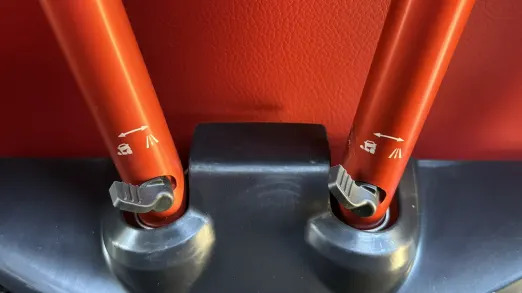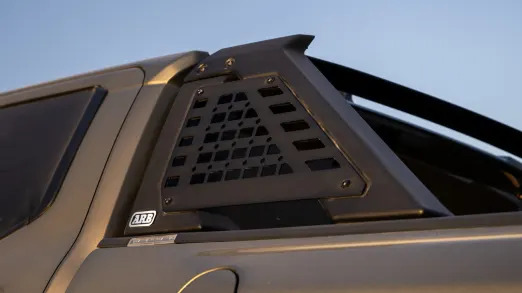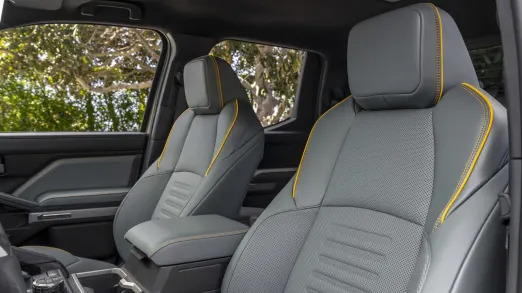SAN DIEGO — The 2024 Toyota Tacoma TRD Pro presents a lot of things to talk about, but No. 1 has to be the seats, right? In case you haven’t seen them, the “IsoDynamic” seats in the new TRD Pro have two red shocks on the back, complete with little pressure gauges, in a serious-looking frame with carbon trim and exposed hex bolts. They look incredibly cool; I can totally see someone paying extra for the TRD Pro just to have a truck with seats that look like that. But, they’re a gimmick, right? How much can they possibly do?
Quick answer: Definitely not a gimmick and they actually do quite a lot, even if you don’t realize it, while driving both off- and on-road. How exactly? Each pressurized air reservoir pushes down on oil-filled shocks – one pairing for vertical movement, the other for horizontal movement. A little hand-operated air pump lets you set the air pressure for each reservoir; this can be based on a recommendation from a Toyota app (enter your weight plus the type of off-roading that will be done) or by the old-school method of seeing how much a little rubber O-ring moved during your last off-road foray. There are then little switches at the bottom of each reservoir labeled with on- and off-road icons, but effectively, “on-road” switches the system off by making everything rigid.
I kept them on during my on-road drive from San Diego to the off-road playground the TRD Pro would be more completely tested at (to be fully accurate, I didn’t actually know at the time they could be turned “off”). My first impression of the drive was the TRD Pro had a much better ride than the TRD Off-Road I drove the day prior, or, more specifically, it didn’t suffer from the same wiggling and jiggling over bumps indicative of a body-on-frame vehicle. I initially chalked this up to the TRD Pro’s Fox QS3 Internal Bypass Shocks that are specifically designed to cushion the blow of landing this sucker back down on Earth. But then I drove the TRD Pro on a pock-marked, rock-strewn disaster of a road at 40 miles per hour before launching it airborne. Not only was my landing surprisingly cushioned (what you’d expect those seats to accomplish), I wasn’t violently vibrating with the rest of the truck and my vision was clear. That is what these seats do, and it’s incredible. And don’t just take my word for it.



Les Betchner was one of the off-road driving experts on hand to make sure journalists wouldn’t do anything stupid, while also egging on others (this guy) to gun it on a pock-marked, rock-strewn disaster of a road with a looming jump.
“You can carry on a conversation over the roughest bits of road with them, but no way without. There’d be too much vibration,” he said, literally proving the point while we traversed an off-road trail. He also said there’s a huge difference over jumps/landings and big whoops. “Normal seat springs can’t possibly absorb that energy, but the big shocks can.”
The one downside is the seats are incredibly thick, reducing legroom in a back seat that was hardly spacious to begin with. Otherwise, totally positive. Available in a choice of red or black leather, both with the TRD Pro’s unique camo print, they’re actually incredibly snug, supportive and really comfortable even if you turn the shocks to their on-road “off” position. Should you, though? Tacoma chief engineer Sheldon Brown said he keeps the vertical shock “on” while out in the real world, but noted that sometimes leaving the horizontal shock “on” can make it feel like your seat is scooting a bit in certain situations, like a cloverleaf on-ramp. Either way, you can literally just reach behind you and turn the switches.
That’s not the only manually operated switch aboard the 2024 TRD Pro that makes for more customized off-roading. Take a look under the front suspension, and you’ll notice the little knob poking out from those Fox QS3 shocks you can turn to levels 1, 2 or 3. This “Quick Switch 3” manual adjustment of compression damping basically lets you set the firmness of the shocks to match the terrain. Chief engineer Brown said his on-road suggestion is Level 1, while our whole day of off-roading (including that jump) was accomplished with Level 2. He said Level 3 is “for serious compression,” which is obviously more than the 2 feet of air I got. Yee haw.



Both the seats and the suspension speak to the new TRD Pro’s added emphasis on being a high-speed desert runner – Toyota’s answer to the Ranger Raptor, if you will. What’s under that bulging hood underlines that point. Standard is the i-Force Max hybrid powertrain that sandwiches a 48-horsepower electric motor between a 2.4-liter turbocharged inline-four and eight-speed automatic transmission. Combined output is 326 hp and 465 pound-feet of torque, which Toyota notes is a 75% torque increase over the old Taco’s weak-sauce V6. It’s also 35 more pound-feet than the Ranger Raptor’s turbo V6, even if the Ford has a cool 79-horse advantage. I didn’t drive them back-to-back, but I have driven both. If the Ford is quicker, I doubt it’ll be by much. The TRD Pro’s hybrid powertrain is every bit the performance engine, and it sounds cooler, too. The added TRD performance air intake and cat-back, dual-tipped exhaust make it sound mean, especially compared to the same powertrain in the TRD Off-Road (where it’s an option). It also doesn’t suffer from the same omnipresent and tiresome drone of the old TRD Pro exhaust. There’s still some four-cylinder buzz, but if you’d rather have the old V6 than this, you’re nuts.
Other elements included with the TRD Pro are the new, manually disconnecting front stabilizer bar (which increases suspension articulation while rock crawling), Fox External Floating Piston rear bump stops (more landing gear), 33-inch Goodyear Territory Rugged-Terrain tires wrapping 18-inch black alloy wheels (these were surprisingly quiet on-road), an electronic locking rear differential (the TRD Off-Road gets this, too), a 20-inch light bar integrated into the front fascia, and a rear bumper and tow hooks sourced from ARB. The suspension upgrades and big tires also contribute to Tacoma-best clearances of 35.7-degree approach, 24.6-degree breakover, 22.6-degree departure and 11.5 inches of running ground clearance.
While the TRD Pro sends itself in the direction of high-speed desert running, Toyota has introduced the 2024 Tacoma Trailhunter for those more interested in rock crawling and overlanding in particular. It too comes standard with the high-powered hybrid, locking rear diff, disconnecting stabilizer bar and 33-inch tires (albeit on extremely cool bronze wheels that match the truck’s TOYOTA badging up front), but differs with its suspension. It gets bespoke Old Man Emu (OME) position-sensitive forged monotube shocks with remote reservoirs tuned to accept greater weight while off-roading (overlanders carry a lot of stuff) and provide greater control in rockier events. It also gets unique rock rails and high-strength steel skid plates, its own steel rear bumper and hooks, and, most obviously, the “sport bar” arching over the bed with removable MOLLE panels. That’s the Trailhunter’s answer to the TRD Pro’s “I want that!” Isodynamic seats. And no, you can’t get those on the Trailhunter. I would think customers might demand that change and, personally, I think they’d still look cool in the Trailhunter’s exclusive “Mineral” green interior color.
While the TRD Pro is offered with a 5-foot bed only, the Trailhunter gets the option of 5- or 6-foot beds. And while the long bed reduces breakover, its increased bed space satisfies the truck’s overlanding mission. In short, you don’t have to be short to sleep in it or above it while camping.
Not surprisingly, the Trailhunter proved more than capable of traversing the rugged off-roading course Toyota created for the press launch. Its disconnecting stabilizer bar helped the tires maintain contact with the ground while also keeping the truck more level over severe one-side-up, one-side-down events. I didn’t drive the TRD Pro on the same course, though, nor did I drive any rival truck. I also can’t say the course was especially gnarly – I did it in Land Cruisers the day before.




The on-road drive was actually more telling. There was indeed more wiggling and jiggling without the fancy seats, but the Tacoma Trailhunter is still a nice riding truck with a tidy size better suited to more congested suburban roads and highways. Once again, the power on tap impressed, but while the TRD Pro provides some audible sizzle with its TRD intake and exhaust, the Trailhunter has something entirely different. You’ve probably noticed the factory-installed, low-profile secondary air intake attached to the passenger-side A pillar. People often call these snorkels – this was the first vehicle I’ve driven with one and, sure enough, it literally sounds like air being sucked into a snorkel. I found it quite amusing, especially with the passenger window down (your passenger may not appreciate this). There’s a delightful mixture of whooshing and suction noises as you go on and off the throttle. Hmm, maybe this is the Trailhunter’s “I want that” feature.
Either way, it’s easy to see that the Tacoma’s enormous fan club is going to grow, or at least become even more devoted with the introduction of the Trailhunter and the TRD Pro’s serious enhancements. They are cooler and more capable from the get-go, limiting the amount owners will need to fork over to aftermarket outfitters. Of course, they’ll be forking over plenty to Toyota instead, with the Trailhunter starting at $62,900 and the TRD Pro at $63,400. These are comparable to a Chevy Colorado ZR2 Bison, but several thousand more than the lesser ZR2 as well as the Ranger Raptor.
There’s also still plenty left to customize, and indeed chief engineer Brown said he thinks it’s a positive that Tacoma buyers want to take their trucks in a different and/or more extreme direction. That’s one of the reasons his team went with the manually disconnecting stabilizer bar instead of the more complex KDSS automatically disconnecting system found in the old 4Runner that, while arguably more capable, makes it harder to modify the suspension.
Have it your way, as the Burger King would say. But if you want those seats – and believe me, you want those seats – the way you want probably starts with the TRD Pro.
Related video:








